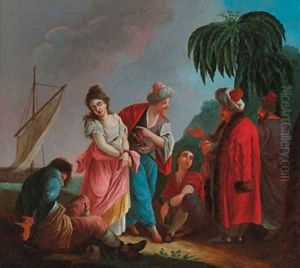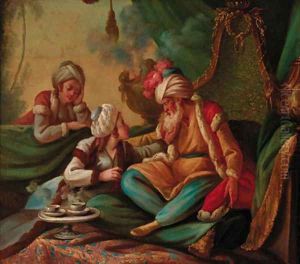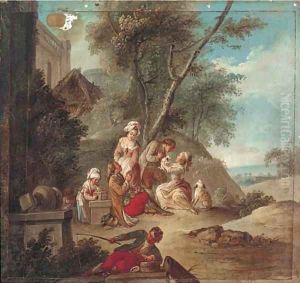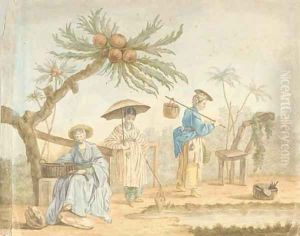Jean Baptiste Leprince Paintings
Jean-Baptiste Leprince was a French painter and etcher, known for his innovative genre scenes, landscapes, and ethnographic depictions of Russian life. He was born on September 17, 1734, in Metz, France, into a family of painters; his father, Anne Le Prince, was a painter and director of the local academy. Jean-Baptiste showed early promise in art and was sent to Paris to study under the well-known rococo painter, François Boucher.
Boucher's influence is evident in Leprince's early works; however, Leprince soon developed his own distinctive style. His life took a significant turn when he traveled to Russia in 1758. He spent several years there, working for the imperial family and other members of the Russian aristocracy. During this time, he extensively documented Russian folk life, landscapes, and customs through his art, which was somewhat unusual for Western European artists at the time. His observations of Russian subjects were not only ethnographically interesting but also novel to his contemporaries in France.
Upon returning to France in 1763, Leprince brought back a large collection of drawings and objects that influenced his subsequent work. He translated these experiences into a series of Russian-themed paintings that won him recognition and acclaim. These works were among the first glimpses that Western Europeans had into life in Russia, and they contributed to Leprince’s reputation as an innovative and exotic genre painter. He was received into the Académie Royale de Peinture et de Sculpture in 1765, where he presented his morceau de réception (reception piece), an honor that marked him as a significant artist of his time.
Leprince also experimented with aquatint, a printmaking technique that allowed for a more painterly representation of tones and textures. This made him a pioneer in this medium in France. His prints contributed to the dissemination of his Russian subjects and also included other themes, such as domestic French scenes and landscapes.
Leprince's work was characterized by a lively depiction of figures, a masterful use of color, and a keen observation of everyday life, which resonated with the sensibilities of the Enlightenment era. His paintings often conveyed a sense of narrative, inviting the viewer to ponder the stories behind the characters depicted.
Jean-Baptiste Leprince died on September 30, 1781, in Paris. His unique contributions to French art, especially his introduction of Russian themes and his advancements in etching, have earned him a place in art history. His work provides valuable insight into the cross-cultural exchanges between Europe and Russia in the 18th century and reflects the broader trends of the Enlightenment, including an interest in other cultures and societies.



